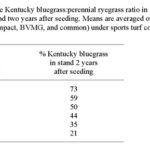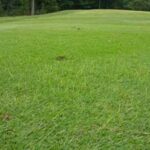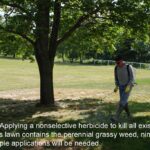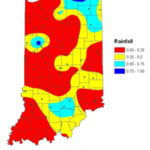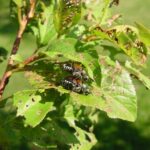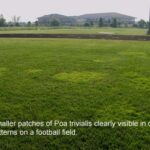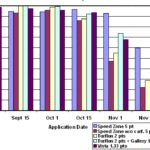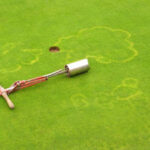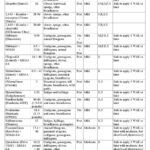Homeowner
How much perennial ryegrass Kentucky bluegrass in a mix?
With the renovation season fast-approaching, questions abound about how much perennial ryegrass to use in a P. rye/K. bluegrass mix. Perennial ryegrass germinates quickly and provides quick cover and soil stabilization when used in a blend. However, too much perennial ryegrass leads to long-term problems from dollar spot, brown patch, red thread, and other diseases. […]
Something New in Golf Course Turf…Ghost Grass and Mad Tiller Disease???
Photo by: Steve McDonald of Turfgrass Disease Solutions located in Philadelphia Photo by: Cale Bigelow in West Lafayette Over the past week a relatively new turf malady has become prevalent on golf turf throughout the region. This new phenomenon has been referred to as “Mad Tiller Disease”, and “Ghost Grass” in the United Kingdom , […]
Turf Field Day Held July 17
Thank you to everyone who attended and helped make the 2007 Midwest Regional Turf Field Day a success on Tuesday, July 17. Though we had rain for the first time in at least 19 years that dramatically affected the day, this years registration easily topped 700. Attendees had the opportunity to view the latest in […]
Preemergence herbicides starting to break in hot spots
Crabgrass is starting to breakthrough in hotspots next to walks and drives, southern exposures, and in thin turf. Though many are quick to question the effectiveness of the specific preemergence herbicide used last spring, the vast majority of the breakthrough is due to weather, environment, or application techniques. Our research plots this year are showing […]
Nematode Survey Still On-Going
As summer stresses start to take a toll on our cool-season grasses on greens, more questions are arising about the potential of nematodes. We found ring and stunt nematodes in many of our samples from last year, but we’re not convinced yet that they are a primary cause in turf decline (see http://www.agry.purdue.edu/turf/tips/2006/nem112.htm for complete results). Pinpointing […]
Now is the Time to Start Improving Your Lawn
Tired of the way your lawn looks? If it hasn’t looked up to par this summer reseeding your lawn is an option. Mid-August is the best time to seed a new lawn or overseed an existing lawn, but planning should start now. If the lawn is just thin and needs a little help, fall is […]
White Clover in Golf Courses, Sports Turf, and Lawns
The small white flowers of white clover are very visible right now and it may appear that clover is taking over, especially under-fertilized turf areas. Clover is a legume and is very competitive under low N conditions, so increasing annual N is the best method for long-term control. The temptation is to apply a herbicide […]
Crabgrass and Yellow Nutsedge
Crabgrass and yellow nutsedge are really starting to flourish. Unfortunately, our options for control of either weed are becoming limited. Plus the hot temperatures increase the risk for turf damage with any herbicide applied now. The best current option for crabgrass is quinclorac (Drive or Quinclorac), which has the best activity among all the post […]
Misery loves company: Yesterday’s state rainfall map
Though West Lafayette was lucky enough to get significant rainfall yesterday, not many other places in the state were as lucky. Below is a state rainfall map, courtesy of the Indiana State Climate Office. This information and much more weather information is available at www.iclimate.org
Lawn blemishes exposed by drought
Maintaining lawns and other turf areas is fairly straightforward in the cool and wet weather of the spring and fall, but things get tougher once the heat and drought set in. We are currently seeing a wide variety of problems, all of which are enhanced by the dry conditions. Problems that we are seeing include: […]
Don’t raise the mowing height during drought
Typical advice in the paper and TV is to raise the mowing height during drought to help the turf area stay green. However, this is very simplified advice which needs clarification. Here are some well-researched facts: • The higher you mow a grass plant, the deeper the roots. • Deeper roots mean a larger reservoir […]
Facts and Advice on Turf Survival in Drought
There are many questions about turf survival in drought with the on-going drought in most parts of the state. Though we understand many of the mechanisms turf survival in drought, it’s hard to duplicate all of the potential situations on research plots across the country and it’s difficult to give definite “black and white” recommendations […]
Early Japanese Beetles
It seems that the Japanese beetles have been arriving early for the last few years but this year is truly an exception. The first Japanese beetles of the year were observed in central Indiana on the 3rd of June. This is a full week earlier than we have EVER seen them here before. Normally, Japanese […]
Early billbug activity
It appears that our unseasonably warm spring has pushed the activity of many insects as much as 2-3 weeks ahead of traditional expectations. Among the turfgrass insects that are showing up early this year are the billbugs. These insects over-winter as adult weevils and become active in the spring when soil temperatures reach about 50°F, […]
Controlling Poa trivialis in sports fields
Poa trivialis is now common in sports fields, possibly due to as little as one contaminated seed source from the many overseedings done on sports fields. Once germinated, Poa trivialis spreads via stolons which may be further spread during every hollow tine aerification. Poa trivialis is shallow rooted, has poor wear resistance, is extremely susceptible to dollar spot, and often […]
Controlling ground ivy and/or violets
Ground ivy and violets are currently flowering and at their peak of beauty, but these two weeds remain tough to control in Indiana . Like almost all broadleaf weeds, flowering indicates a point in their lifecycle where they are susceptible to herbicide application. Even though applications now can produce visible damage, long-term control does not […]
Brown Ring Patch / Waitea Patch
There are sporadic reports of brown ring patch (formerly called Waitea patch) from across the Midwest . Interestingly, the disease currently is causing concern in southern California as well. The risk of structural damage (a.k.a. dying turf) is greater on putting greens than on turf mowed at a half inch or higher. Otherwise, effects are […]
We need help tracking new white grub species
The presence of two potentially serious white grub pests of turfgrass and ornamental plants has recently been confirmed in three northern Indiana counties; Porter, St. Joseph and Allen. The European chafer and Asiatic garden beetle are similar in biology to their cousins, the masked chafer and Japanese beetle, yet differ enough in behavior, habitat and […]
Weed Control in Newly Seeded Bermudagrass
Bermudagrass seeded or sprigged into damaged areas will require weed control to maximize establishment. Most herbicides carry precautions on use in sprigged bermudagrass, but few carry recommendations on use in seeded bermudagrass because of the newness of seeded varieties. Following is a table of herbicide recommendations gleaned from the latest research on seeded bermudagrass. Herbicides […]
Bermudagrass Winter Survival and Cultivar Selection
With the bermudagrass damage in southern IN and Kentucky , we are fielding many questions on cultivar survival. Following is our winterkill data from 2003 of bermudagrass grown in West Lafayette under fairway conditions. Combining this data and other data from across the country, I would recommend in order the following cultivars of bermudagrass for […]
